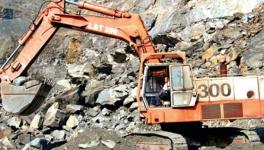Diamond Mining in Panna: Illegal Excavations and Inconspicuous Auctions
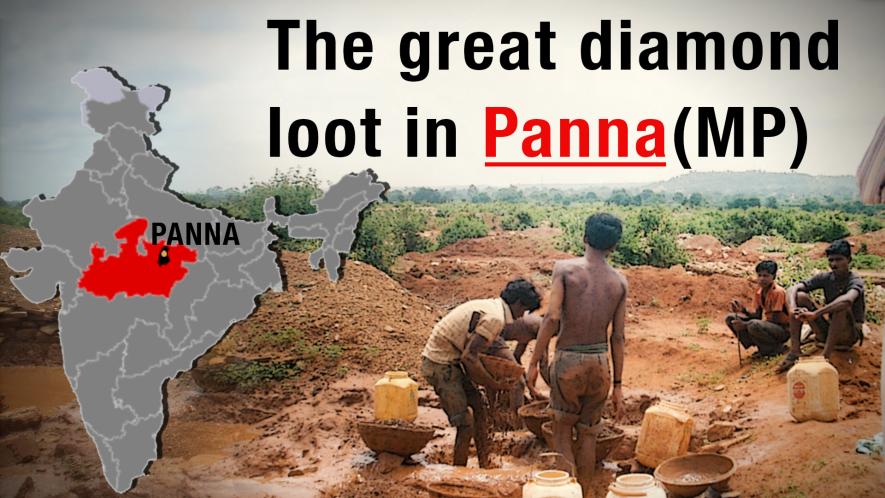
Panna: On the morning of July 24, six forest personnel were assaulted by a group of people who were allegedly involved in the illegal diamond mining in Vishramgunj range (Rahuniya Beat) of Panna Tiger Reserve of Madhya Pradesh.
The forest cops had gone to raid the illegal diamond excavation site after recurrent complaints.
No sooner than the forest cops raided and detained two people from the illegal mining site, a group of people, carrying fire arms arrived in vehicles and reportedly got their accomplices released at gun point. They brutally assaulted the unarmed forest guards including a ranger and fled the spot.
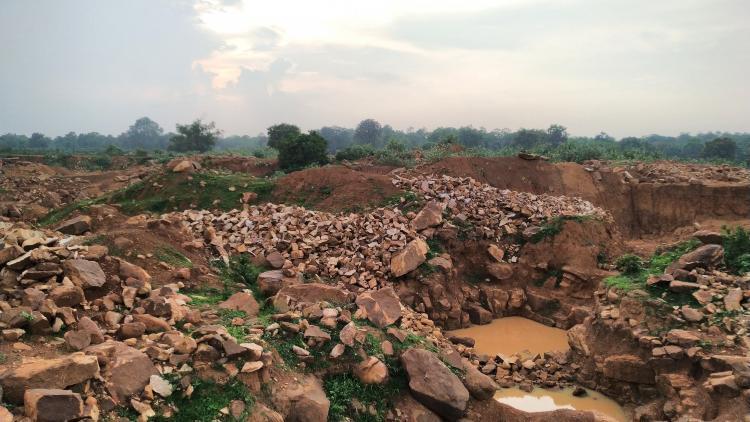
Illegal Mining Site near Mahua Tola Panna. Image Courtesy: Kashif Kakvi
An FIR has been registered against six people at the Brijpur police station, and two accused have been arrested so far, said Panna District Forest Officer Naresh Yadav.
Forest Department has time and again run a campaign to curb illegal mining and has raided those areas; seized the vehicles and digging equipment, but, nothing has changed. Illegal mining continues unabated.
Brijpur, Paharikhera, Vrispati Kund, Manjha, Khirwa, Rahuniya, Pali Garhara of Vikramgang range including Khinni Ghat, Mahua Tola and Sakariya are some of the areas which fall under the limits of Panna Tiger Reserve, but, are under the grip of illegal diamond excavators.
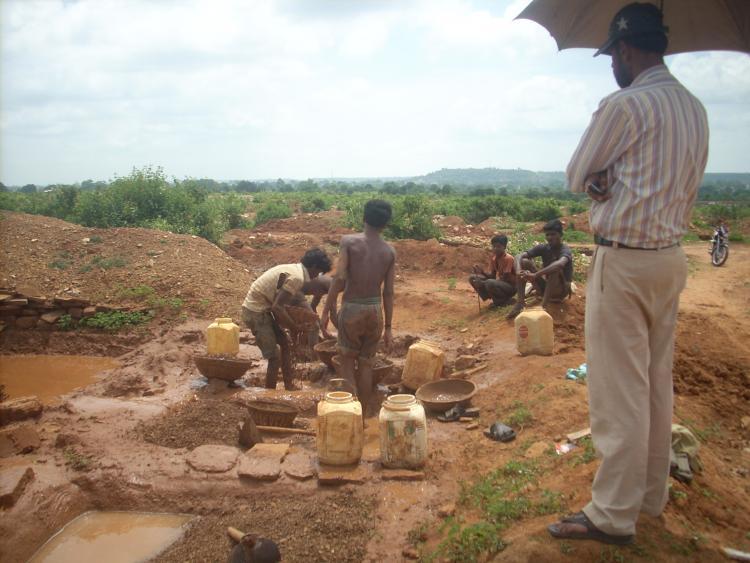
Illegal Mining Site near Brijpur,Panna Image Courtesy: Kashif Kakvi
Illegal diamond mining allegedly takes place with the support from politicians, government officials and the Forest Department.
This is the state of affairs in India’s only diamond mining district Panna, which has Asia’s best diamonds. Geologists claim that Panna and some pockets of adjacent district Chhattarpur have the best-quality diamonds in the continent. Ironically, the government-run diamond miner controlled by National Mineral Development Corporation (NMDC) in Majgawa (15 km away from the Panna headquarters) – which has been operation in the region for five decades – is on the verge of closure.
NMDC is one of the Navratna companies [nine gem-like companies] owned by the Government of India, under the administrative control of the Ministry of Steel. It is involved in the exploration of iron ore, copper, diamond, etc.

The only Diamond Mining Plant of India Run by NMDC in Panna. Image Courtesy: Kashif Kakvi
Panna has three kinds of diamonds: gem (the costliest), yellow and dark brown (industrial).
The NMDC has been seeking extension of existing mining pit to 10 more hectares from the State Forest Department. The current pit is spread between 13-14 hectare with a depth of 116 meters and till now, more than 10 lakh carat diamonds have been excavated.
According to a top NDMC official, the adjacent area has more than 9 lakh carat diamonds, which can prove to be hugely profitable to the country, without harming the environment.
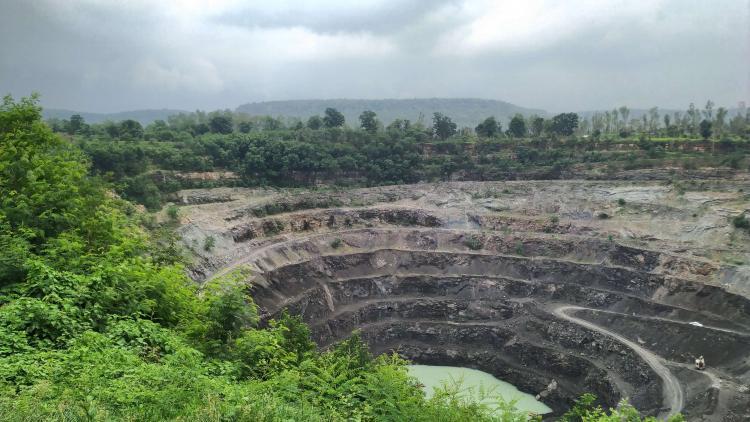
The Diamond Mining Pit of NMDC, Panna. Image Courtesy: Kashif Kakvi
However, the Forest Department and Tiger Reserve administration are in no mood to relent citing tiger conservation.
“We want extension of existing pit because the area adjacent to the mines has the best diamonds in the world, according to the experts. The present mine may be shut down in the next 10-15 years, but, if we get the extension, we can excavate diamonds for more than four decades,” said NMDC official and GM of India’s only diamond miner, Majgawa (Panna) Diamond Mining, Rajeev Sharma.
“The extension of the pit will not only generate wealth and employment in the district, state and the country, but will also bring glory to the country; however, the Forest Department wants us to leave, as they cite threat to the forest and the tigers,” Sharma said.
“The Forest Department claimed that we are harming the climate and we should leave, but, they can never produce evidence of any harm we have caused in the past 25 years. We do want to conserve the forest, and we have planted lakhs of trees,” claimed Sharma.

Diamond Segregation Plant NMDC, Panna. Image Courtesy: Kashif Kakvi
Another official, requesting anonymity, claimed that the Forest Department wants to close the only diamond mine of the country in lieu of tiger conservation, but has failed in curbing the illegal diamond mining which is rampant in parts of the tiger reserve.
Commenting over the issue, a local journalist alleged, “In the shadow of ‘saving tigers’, corruption and theft is rampant here. Illegal diamond mining, theft of logs, chironji and Mahua is very common. Tribals are being framed under fake cases by the Department.”
When NewsClick tried to contact the District Forest Officer of Panna Naresh Yadav, he refused to comment and disconnected the call.

District Forest office (South), Panna. Image Courtesy: Avinash Rawat
Besides, despite several attempts, the Field Officer of Panna Tiger Reserve KS Bhadauriya did not respond to calls or messages.
Why illegal mining?
As Panna National Park came into existence in 1993, more than 50 diamond mining sites, which were under the Madhya Pradesh Mineral Resources Department (MRD), went to the State Forest Department or Panna Tiger Reserve administration and mining become prohibited according to the Wildlife Protection Act, 1972, in those areas. Subsequently, the MRD was left with only three patches of land known to have diamonds; Krishna Kalyanpur (spread over 1 km), Raksheha (500 m) and Sakariya Chopra (1 km), according to the data provided by the District Diamond office.
According to the laws, to excavate diamonds from any kind of land (private or government) in Panna, one needs to take permission from the District Diamond Office (DDO), Panna.
District Diamond Office, Panna. Image Courtesy: Kashif Kakvi
On application, DDO allocates 8x8 metre land to any individual for diamond excavation for a year with a minimal fee of Rs 200. If any individual finds diamond, he has to submit it to the DDO. The diamond valuer of the DDO office fixes the rate and auctions it. The auction takes place four times a year. With reduction of 12.5 % tax from the sold diamond, rest of the money goes to the diamond excavator.
Permit Issued by DDO Panna to Individual. Image Courtesy: Kashif Kakvi
Interestingly, the land that DDO can allocate has been dug for decades and now, no place is left to dig. Despite this, hundreds of people apply to excavate diamonds every year to try their luck. In 2019 itself, more than 550 people have applied for it.
Now, the game of illegal diamond mining begins here. Those diamond mines, which went to the Forest Department since the Tiger Reserve came into existence in 1993, open the gates for illegal mining.
Govt. Owned Kamla Bai Talab Which is being dug for last couple of decades.
With the support of local leaders, influential people and locals dig for diamonds whenever they get a chance. Brijpur, Paharikhera, Vrispati Kund, Mangla, Khirwa, Rahuniya, Pali Garhara of Vikramgang are some of the major places of diamond mining, however, the Forest Department has no mechanism in place to prevent it.
According to a local, Mohammad Ashraf, people get the government land allocated just to sell their illegally excavated diamonds. They excavate diamonds from prohibited areas and submit it to the DDO office saying, 'we found these in the government-allocated land', he said.
“The rate of diamond in black market is lower than the government’s rate. Those who find big diamonds and want good money, submit it to the diamond office, but, they also fear for their lives. Money and publicity bring threat to their lives,” said Ashraf.
Modus operandi and Rates
According to sources, with the help of marginalised sections of society including tribals, influential people run illegal diamond mining syndicate. They dig diamonds from wee hours to 10 AM after identifying the area – no matter whether it’s the government land or tiger reserve. They do it at gunpoint.

Men excavating diamond near Vishramganj Range.
Sometimes they do it on a contract basis or percentage basis [60%-40%]. They provide land, protection and sell it, while a group of labourers excavate diamonds. Whatever amount they receive is then distributed, said a labourer who used to excavate diamonds.
After the excavation, they wash it, segregate the diamonds depending on colour, quality and carat as well as type.

Diamond Segregation Pit
Subsequently, they inform the agents from their villages who have contacts of the potential buyers. Buyers visit the village with a diamond valuer, fix rates, pay in cash and leave the diamonds with the agent. The agents take 2% of the total value as commission and are responsible for providing safe passage to the buyers.
According to an agent, the big diamond buyers from Mumbai and Surat have stationed their men in Panna to procure diamonds. Buyers’ agents stay in the hotels, and their subordinates (mostly locals) stay in the villages, who are usually in touch with the illegal diamond excavators. When good-quality diamonds are found, the buyers are informed and a rate is offered. “They buy all the illegally excavated diamonds. The average rate of the gem is Rs 1.20 lakh per carat in the black market. The rate goes up if the size of the diamond is big,” said the agent, requesting anonymity.
A local journalist claimed that everyone is involved in this racket – from police, Forest Department to politicians. “Everyone gets their own share. They talk about tiger conservation, but shut their eyes when it comes to illegal mining,” he said.
Recalling one incident, the journalist said that once, a dozen local journalists decided to visit the illegal diamond mining site to expose it. “No sooner than we reached there, the guards encircled us, snatched mobiles of some journalists. In between, one of the journalists informed the police and they saved us, but did nothing against the illegal diamond excavators. On the contrary, the police warned us ‘not to visit such places without security’.”

Pit dug by diamond excavtors with JCB in Dehlan Chouki of Panna.
NewsClick team visited some of the areas – forest and government lands – where illegal mining is underway. One can see that the mountains, forests, agriculture land and even government land have been dug, as the excavators continue unhindered.
Mining in individual or private lands
Panna has no land to offer to the buyers; not even agriculture land. Instead of farming, farmers have been trying to dig diamonds from their land.
According to the laws, any individual who owns land in Panna can excavate diamonds. But, one should have the permission of the DDO. Rules are the same: submit application and obtain a permit for a year.
In places like Dahlan Chouki, Pati Bazariya, Brijpur, Sarkoha, owners excavate diamonds from their own lands. They hire locals and labourers on the percentage ratio of 70:30. They use heavy vehicles like JCB to dig, which are in fact prohibited by the government.
“We get quick money, no publicity and no risk,” said 20-year-old Abhishek* (name changed) from Dehlan Chouki when asked why the land owners choose to sell the diamonds in the black market.
Abhishek’s family has been excavating diamonds for years. As per his claim, they earn between Rs 6 lakh and Rs 8 lakh per year from it.
“If we submit it to the government, surely, we get good money, but it takes months. Then, we need to specify where we have excavated it from. Besides, it is published in newspapers. The publicity and money brings threat to our business. So, we sell it directly to the buyers,” said Abhishek.
Lack of transparency in diamond auction
The DDO organises auction of diamonds four times a year – in January, April, July and October. A notification is issued with a date to inform the buyers and diamonds are auctioned in an old fashion.

Panna Diamond Auction.
In 2017, the Panna District Diamond office sold 347.51 carat diamond worth Rs 39,36,722. The following year, the office sold 308.68 carat diamond of worth Rs 3,04,11, 215 through auction, including a 42.59 carat diamond of a labourer, Motilal Prajapati, (42) which was auctioned at Rs 2.55 crore.
But, in this digital era, when Union government is emphasising importance of digitalisation to usher in transparency, the auction has been taking place in an old-fashioned manner.
The only diamond valuer of the country fixes the rate. The Department does not advertise the auction on national platforms; same buyers appear every time, and no cameras are used during the auction.

Buyer participating in Panna Diamond auction.
A local journalist, who has been going for the diamond auction for the last couple of years, raised suspicion over the transparency of the entire process.
“This is a national event which takes place only in Panna. It should be advertised in national newspapers, on national television, social media, etc., so that the national and international buyers pay attention and participate in the auction. If diamonds sells for higher rates, evidently, it will benefit the government,” said the journalist, who runs a website here.
When contacted, District Diamond Officer of Panna RK Pandey said, “We inform the local newspapers about the auction and send WhatsApp messages to our permanent buyers. That is all we do.”
When asked why the department does not advertise widely or use cameras during the auction, he said, “We are planning to use cameras during auctions, but, never thought about using other media.”
Get the latest reports & analysis with people's perspective on Protests, movements & deep analytical videos, discussions of the current affairs in your Telegram app. Subscribe to NewsClick's Telegram channel & get Real-Time updates on stories, as they get published on our website.














